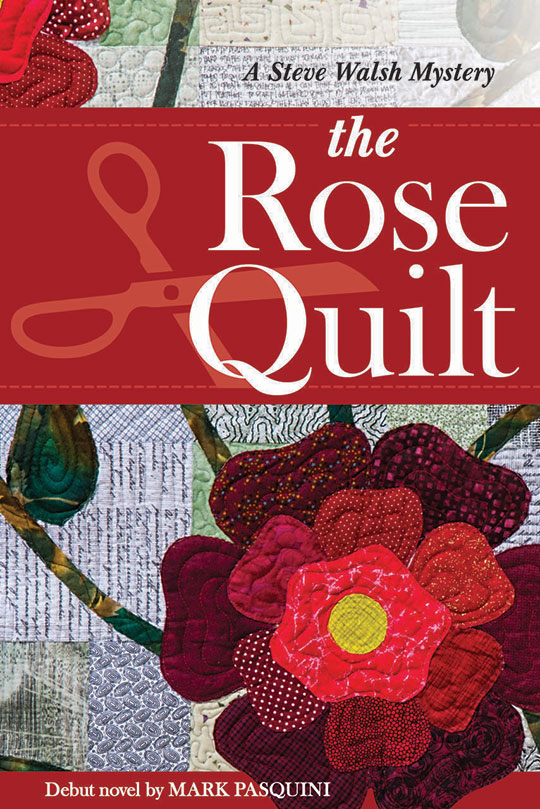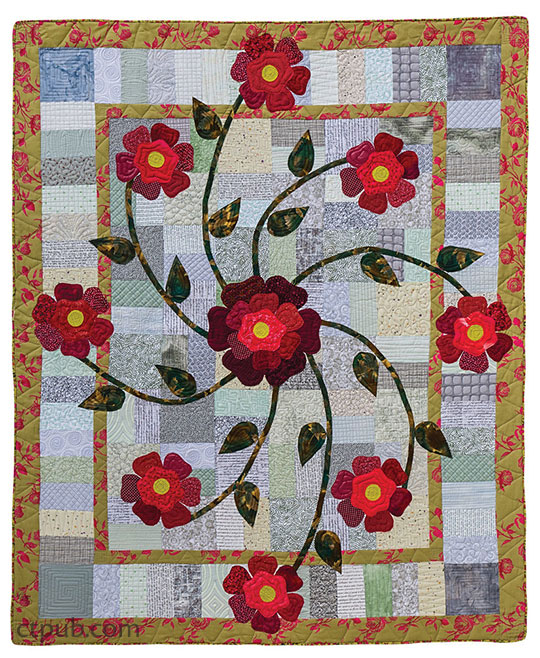A Cozy Mystery with a Dash of History
Posted by Roxane Cerda on Nov 1st 2017
No one can quilt all the time—or at least I try to remind myself of this on occasion. When you just don’t feel like hauling out all your fabric or standing over your cutting mat, curling up with a cozy read and a cup of coffee can be just the thing. I read voraciously, so adding novels to our publishing program has long been of interest to me. We’ve had proposals for fiction from time to time, but the fit just never seemed quite right.
Cue Mark Pasquini. Does his name sound familiar? If you are an art quilter, it should, as he is the brother of Katie Pasquini Masopust. Katie is one of our well-loved authors, and she encouraged Mark to bring his mystery, The Rose Quilt, to C&T.

The Rose Quilt was just the fit I was looking for! The characters are diverse and engaging, and the title quilt plays a pivotal role in the resolution of the mystery. Add to that the threads of history, small-town and national politics, and committee intrigues and you have a lively read set in a prohibition-era small New England town.
I was thrilled to get a chance to work with Mark and his veteran fiction editor, Kate Homan. They both taught me more about the craft of creating fiction, and I can’t wait to share this novel with our readers.
Just to give you a taste of what you can look forward to, here is an excerpt from The Rose Quilt:
LOCATION: Chandler Mansion, Chandler, Connecticut
DATE: April 1923
Mrs. Chandler asked, “Anna, will you draw it up for us, please?”
Mrs. Chandler traded positions with Miss Carlyle, who took a small pouch out of her bag, extracted an artist’s charcoal pencil, and began to draw. Strong, bold lines created the frame. Quick, sure strokes sketched the central rose and four sweeping lines to represent the branches, each ending in a smaller version of the central rose. She added four shorter curves and ended each one with a small rose. She added narrow diamond forms at random to the branches to represent the leaves. When she was finished, she pinned it up on the board.
Mr. Jones tapped his blunt fingers on the table and offered, “The leaves. I’d make them look a little rounder, sort of like real leaves.”
After a murmur of agreement, Miss Carlyle softened the foliage.
A few moments later, Mrs. Flowers said, “The center doesn’t feel right. Would another border on the outside of the inner roses define the center—accent it?”
The professor raised his hand and said, almost apologetically, “The inner roses—maybe buds instead?”
Miss Carlyle bent over the table and began to draw. She pinned up the new picture. The committee saw an outer border with roses at the compass points. Inside of those roses was another, thinner border. In each corner was a stylized rosebud. The center contained a larger rose with six petals. Randomly from between the petals came the branches in a clockwise flow to attach to the small roses and buds. Three leaves were attached randomly.
“Not so good,” Professor Poltovski observed in his heavy accent. “Not buds; back to roses is better.”
The rest of the committee expressed their agreement at the restored design, though Mrs. Chandler noticed that Mrs. Black’s was tepid. She tapped a fingernail on the table to bring order and continued, “Now, let us decide on the general colors.”
Mrs. Flowers said, “The roses, of course, will be in shades of red—possibly each petal a different shade—and the branches and leaves shades of green? I noticed, too, when I was in the print shop at the mill that there was a bolt of olive cloth with magenta roses on it, which might be used for the border.”
Mrs. Black stated with a hint of acid in her voice, “Certainly. That is obvious and needn’t even be stated. As to the border, the whole committee will decide on that.” Mrs. Flowers ducked her head in embarrassment. Mrs. Black had never lost an opportunity to crush her since the scandal.
Another fingernail tap from the hostess silenced the attack by the small, acerbic woman. “The only question is which colors for the interior and border, which Mary might have solved for us. First of all, we have a large quantity of cloth from past years. I think a light background would highlight the flowers, and, since there is such a quantity of remnants, that a somewhat scrappy quilt would be in order. I am having the backing material printed in the Chandler Mills print shop. Professor kindly helped me with the Latin. It is a dark background with magenta flowers labeled with their Latin names in a yellow-green tone.”
She turned to Mrs. Flowers and nodded her head in acknowledgment. “I also noticed the remnant from the bolts ordered by the Midwest Furniture Company and had the backing printed with the same colors.” Her tone had a note of finality. “Further, I think Mary’s idea is excellent regarding the border, and, if I recall correctly, there is a sample that we printed with smaller flowers in the same color scheme that the company was also considering.”
After a few minutes of desultory discussion, the olive green and magenta were selected for the border and white and pale gray tones for the background. Mrs. Black was noticeably torn between continuing her pecking at Mrs. Flowers and agreeing with Mrs. Chandler on the color scheme. Soon, all the background colors had been extracted from the piles of cloth and scattered across the table.
Miss Carlyle returned to the piles of cloth and brought out several other swatches. “I think the background is a little too bland. Here are some light greens and slightly darker grays that might bring a little snap without overpowering the red and green roses.” She arranged her new suggestions on top of those that were already down. Then she laid some deep reds and greens on top.
Mrs. Chandler looked at the faces around the table. Mrs. Black, as usual, looked as if she wanted to find fault with something—anything. Miss Carlyle stood with a self-satisfied look on her broad, heavy face. Mrs. Flowers gave a jerky nod of approval, with sparkling eyes. Mrs. Jones twisted her mouth and looked pleased with the palette. The men merely shrugged their agreement.
Mrs. Chandler suggested that the seamstresses—herself, Miss Carlyle, Mrs. Black, and Mrs. Flowers—meet separately to choose the actual cloth for the quilts.
Jeremy entered as Mrs. Chandler was calling for the committee to adjourn for the evening. “Mrs. Chandler, I took it upon myself to retain Mr. Jackson. He is in the kitchen, waiting to convey members of the committee back to Chandler.”
Mrs. Chandler took her place by the door to wish her guests a safe trip. When everyone had departed, she walked back to the sewing room to review the drawings and sort through the material on the table.

*******************
LOCATION: Chandler Hotel Restaurant, Chandler, Connecticut
DATE: June 1923
Steve nodded and took a drink of water, grimacing. “Are you sure there isn’t a speakeasy around here?”
Buck laughed. “Not in this town. You had better bring it yourself if you’re thirsty.”
“Barbarians!” he muttered. He regretted emptying his small flask on the trip down. “All right. This dying clue. Does it point to anyone in particular?”
“It points to everybody, in a way. The main color of the backing cloth was black. Mrs. Black is the executive secretary of the flower show. Latin points to Professor Poltovski, who teaches ancient languages at the college. And the rose part points to Miss Carlyle, who is in charge of setting up the floral displays at the show and is a botanist, and to Mrs. Flowers, the treasurer. The translation of the name, Latin Garden, points to Mr. and Mrs. Jones, who own the local nursery and provide all the plants for the displays, though that is a stretch. Oh, and the pin was shoved through a printed tea rose, and all the children were named after tea roses, Mr. Chandler’s favorite.”
“That would make me want to kill my mom,” muttered Steve, taking another bite.







